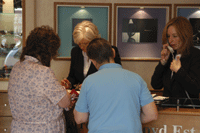More work needs to be done to ensure only those who are eligible receive NHS eye tests or optical vouchers, says the Government's counter fraud service
Fraud committed by patients impacts on optical services every bit as much as it does on other parts of the health service that may, nevertheless, receive more publicity. Patients falsely claiming free optical services cost the public purse £13.25m (1998-99) before measures were put in place by the NHS Counter Fraud and Security Management Service (CFSMS).
 |
| Entitlement to free eye tests or optical vouchers can be based on age, educational status, benefits or medical status |
In 2003 the Counter Fraud Service took on the remit for security management, becoming the CFSMS. This means it is working to improve the safety and security of the staff and facilities of the NHS, and is also putting in place measures to help health bodies do this for themselves.
The CFSMS conducted research into how NHS fraud in the optical sector could be driven down, and in 2001 suggested the introduction of point of service (PoS) checks to help stem the tide of false claims.
PoS checks exist to ensure that people who are not entitled to free eye tests or optical vouchers pay for the service appropriately. They also seek to clarify who is exempt and who is not at the time the claim is made. The aim is first of all to ensure that people intending to claim falsely are aware of the consequences, and secondly to make sure that people do not claim in error.
The PoS checks set out the do's and don'ts of claiming free services for both patient and practitioner. Essentially, they allow both parties to be sure of their rights and responsibilities.
Entitlement to free eye tests or optical vouchers can be based on age, educational status, benefits or medical status. For example, people aged over 60 are entitled, as are patients with diabetes or complex lens requirements. The full range of categories for entitlement can be found in the leaflet
HC81 (Op).
SUPPORT MATERIAL
In response to this comprehensive range of qualifications for free services, the CFSMS has introduced a number of support materials. In essence, however, the basics of undertaking a PoS check are simple: the patient should provide proof of entitlement to exemption with an approved document and, if this is not forthcoming, the claim to be exempt can be checked.
Because of the detailed nature of the entitlement categories, care taken when checking at the point of service can pay dividends. The Patient Checks and Compliance Unit (PCCU), part of the CFSMS, has had the task of helping practitioners clearly identify the entitlement categories, thus reducing the potential for error or abuse.
The PCCU has recently completed visits to some optical practices with a twofold purpose - to increase practitioners' understanding of what they can do to help reduce patient fraud and to listen to optical practitioners, giving them the opportunity to tell the CFSMS what they want. Information packs were sent to optical practices it was unable to visit. Posters, leaflet and guidance for practitioners and staff have been produced as a result of some of this feedback.
The PCCU has conducted similar exercises to pharmacy and dental practices in England. In September 2004, it began visiting optical practices with the aim of addressing every practice in England. This process is now well under way, with the first round complete and feedback is being collated.
So, with this in mind, how can optical staff and practitioners help prevent valuable NHS resources from being lost to fraud? The answer is simple: by conducting a six-step PoS check whenever a patient claims to be entitled to an NHS sight test or NHS optical vouchers.
We ask all practitioners to follow a simple process to ensure a patient's entitlement to free NHS care:
Detailed information for patients is included in leaflet HC81(Op), Help with the cost of NHS optical services - how to claim. The leaflet contains a quick reference table explaining who is eligible for help, what proof of entitlement is needed and where patients can get such proof. It can be obtained by telephoning CFSMS or from the CFSMS website (below). A4 and A3 posters advising patients that they will be asked to prove their entitlement to help with health costs and giving details of where they can get further information are available from www.cfsms.nhs.uk
